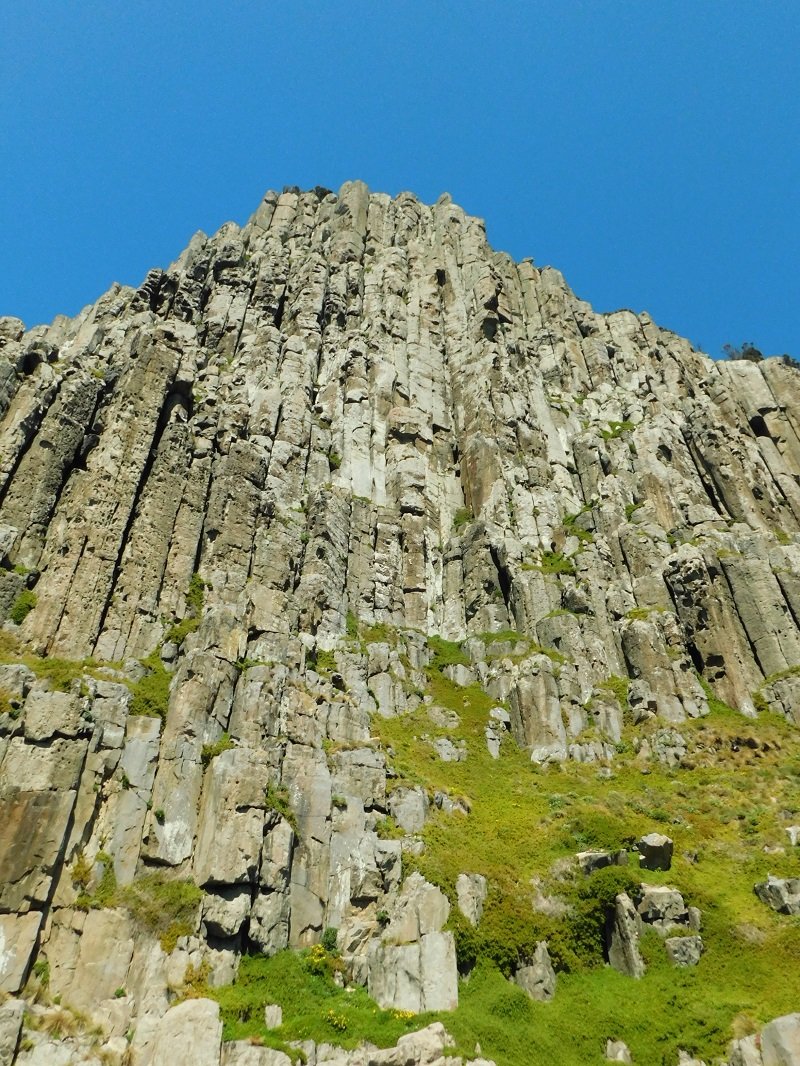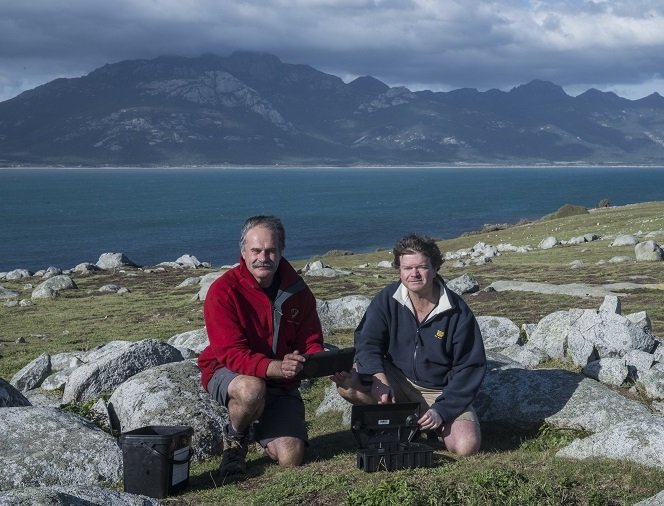Robert Pennicott, the founder of Tasmania’s yellow boat tours, speaks to Mallika Naguran about his ecotourism motivation and conservation efforts, giving a nice ring to the ‘regenerative tourism’ buzzword.
Robert Pennicott is bent on making the world a better place. Pic: Gaia Discovery
Hobart, 30 November 2021. Robert Pennicott is probably tired of looking at cats. The owner of Pennicott Wilderness Journeys has seen more than 3,000 candid pictures of the damage done by feral cats that were running amok on Tasman Island. They sprung on birds as they flapped and landed on what they thought was safe ground (after having braved wild Antarctica winds).
The fairy prion was among the many seabird species that were massacred in Tasmania over time, and he had to do something about it. “An estimated 50,000 to 60,000 birds a year were killed—often the birds had eggs inside them—and the cats were just killing for fun and teaching the youngsters how to do it,” said Robert.
Robert Pennicott and Peter Mooney, then director of Tasmanian Parks and Wildlife, inspect the devastation on birdlife because of predatory feral cats on Tasman Island. Pic: Tasmania Parks & Wildlife Service
Robert and his team, through the Pennicott Foundation’s conservation efforts, supported NGOs and park authorities in reversing the plunging bird population. Tasman Island was declared cat free by 2011.
Conservation is just one of the things that Robert and his team does alongside the business of running coastal tours. “In 2021, we gave to 436 organisations or projects of our own and some of them were very small such as helping fundraisers with cruise tickets or financially supporting island restorations to the way they were before human intervention,” he said, adding, “eradicate cats or rats or that sort of thing.”
Rats? We’ll come back to that in a minute.
I sit across the table from a man with bronzed mop-like hair on the second floor of a container office on Hobart’s wharf. The sun is relentless (rather rare for Tasmania in spring) and the office gets too warm too quickly. Yet his eyes mirror the calm of the blue I could see past his face through the glass windows, amidst the boats.
He is keen to talk, and tell me things. Like why he is committed to a certain kind of tourism—one that’s regenerative even as COVID continues to throw up one challenge after another.
Fisher man turned rat catcher
Going around the lighthouse cliffs with Pennicott Wilderness Journeys is jaw dropping. Pic: Gaia Discovery
Pennicott Wilderness Journeys has been winning awards year after year. Not bad for someone who started out with a hook, line and sinker.
Robert began to skipper his own boat and fish from it at the age of 12. So mesmerised was he by the beauty of the sea cliffs that he made it a point to share it with others. “I took a lot of people previously fishing with me underneath the highest sea cliffs in the southern hemisphere, into caves, up against blowholes, sharing with the locals the dolphins, seals, whales, seabirds… these used to blow them away. And it sowed the seed in starting my own tourism business in 1999 with a little 12-seat boat.”
Losing $40,000 in the first year, and with trial and error, Robert steered a growing business into popularity and nurtured a great team who seem to enjoy their work. The company runs six tours in Tasmania: Bruny Island Cruises, Tasman Island Cruises, Iron Pot Cruises, Tasmanian Seafood Seduction, Bruny Island Traveller and Wineglass Bay Cruises.
Sunbathing fur seals on Tasmania’s craggy rocks. Pic: Gaia Discovery
Over in Victoria, there’s the Wilsons Promontory Cruises—a tour Robert had painstakingly crafted over 10 years, and launched in 2019. Using amphibian boats, the cruise explores a coastline he feels is deeply spiritual (he was invited to create a new tourism product there). “It was because of my passion for the area that I wanted to develop an experience to share with other people. And to me, whenever I go there, shivers go down my spine. It's just an amazing place.”
There are good reasons why Robert is a poster boy for Tourism Tasmania; he has built a credible business from running a small fishing boat of tourists, to what is now a reputable coastal tour operation with 17 boats, 14 buses, and more than 100 staff.
Getting on a Pennicott Wilderness Journeys tour is a good idea if you’re looking for a splashing time with wildlife, including whales if you’re lucky! Pic: Mark Higgins
Pennicott Wilderness Journeys has won 12 Australian Tourism Awards and 29 Tasmanian Tourism Awards including being inducted into the Australian Tourism Awards Hall of Fame for Ecotourism and Sustainable tourism. Robert beamed, “And we also won the Skal International—being recognised as the most sustainable tourism marine business in the world!”
A portion of each ticket sold goes to the Pennicott Foundation, founded in 2011 to fund philanthropic activities. ‘Follow the Yellow Boat’ was the kickoff fundraiser, which saw Robert and two others circumnavigating Australia in a 5.4 metre inflatable dinghy. That alone raised $300,000 to bump up conservation and nudge aside polio.
“Some donations go into the Foundation, but the actual trading company administers the foundation; so, every cent that goes through the foundation is a set of outcomes. And through that, each year, we do more and more and more and more and more,” Robert said, gesturing with his ocean weathered hands.
Entering a cave with incredible geological features. Pic: Gaia Discovery
In 2007, Robert founded the Tasmanian Coast Conservation Fund under the umbrella of Wildcare. He had personally contributed $100,000 since then, protecting, conserving and managing marine and coastal reserves, marine mammals and seabirds.
Apart from getting rid of feral cats, Robert worked strategically with the Aboriginal community, a farmer, parks and Wildcare to exterminate rodents on Big Green Island. “The rats that had been killing about 45,000 seabirds a year,” he said. Among the victims were gulls, terns, shearwaters (mutton birds), the Cape Barren geese and penguins. This prompted urgent and drastic rat buster activities that involved laying 2,200 bait stations across the island.
Robert Pennicott checking out the rat traps on Big Green Island with Peter Mooney in May 2016. Pic: Chris Crerar, Tasmania Parks & Wildlife Service
Thanks to the restoration efforts boosted by $60,000 contribution by Pennicott Foundation, you will not cross paths with a single rat there. Big Green Island was declared rat free in 2016, and there’s a healthy growth of green grass. Monitoring is still on-going with the help of “a beautiful dog that goes across and if it gets within 100 metres of a rat, it goes berserk,” he laughed.
Up to 100 humpback whales were sighted in just one day on Pennicott’s Tasman Island Cruise during the 2020 annual southern migration. They were migrating from the Southern Ocean towards the Antarctic waters during spring (September-November) for a good feed. This typically happens with mothers and their young calves looking to fill their bellies. After a summer of feeding on krill, they migrate north to sub-tropical waters where they mate, and give birth.
Whales are often sighted during the migration season in Tasmanian coasts, feeding on krill in cold waters. Global warming can impact on phytoplankton reproduction, which krills eat. Pic: Mark Higgins
Australia’s eastern coastline and Tasmania enjoy regular sightings of whales. The population of the humpback whale is looking rather healthy, according to Robert, who reckons that the end of whaling in the 1960s-70s had something to do with it. The greater numbers of the humpys (what Australians lovingly call the humpback whale) seen in the southern migration could also be due to environmental changes.
Follow the yellow boat and feel the spray on your face at the Waterfall Bay. Pic: Gaia Discovery
“Well, I think it's probably more that through global warming, there's potentially less krill in the water (up north). And with the mass of whales we're getting now, I think the adults are still doing the north-south migration, but the juveniles are going, hey, there's a fair bit of food around Tasmania, and they hang here, in my opinion,” he said. Traditionally, he added, the whales would go down to Antarctica, to fill up on krill.
I sighted four humpies on a Pennicott cruise the weekend before the interview. It was sunny (did I mention this was rare for Tasmania in spring?), the waters were calm, and my lifelong dream to see the whale had come true. As I gawked at the gentle beast, I forgot to point my camera at them. Robert then told me that his crew across the Wineglass Ba, Tasman Island and Bruny Island cruises had reported sightings of the blue whales, southern right whales, minke whales, sei whales, pilot whales, orcas, and humpbacks this year.
Even whales love Tasmania.
Staying regenerative
Dolphins tease passengers on the three-hour Pennicott Wilderness Journeys Tasman Island cruise. Pic: Gaia Discovery
Robert reckons his tourism approach goes beyond what people would normally associate with sustainable tourism. “You know, when you do win those awards, you probably think you are on the right track; and with sustainability for me, it doesn't just mean environmental. That's a really important part, but it is also about the community. It's about financial, it's about environmental and it's about the staff,” he said.
With a glint in his eyes, he pressed on. “And so, they're the pillars of sustainability that we do and the new buzzword around is regenerative tourism. And basically, that's a lot more than sustainable, you know, in that it is continually wanting to make things better, in my opinion.”
Certification is important too, he said, as that boosts not just customer confidence but staff loyalty as well. Having been assessed by Ecotourism Australia, Pennicott Wilderness Journeys is an Advanced Ecotourism Certified operator.
While Pennicott Wilderness Journeys has in place a 100% carbon offset policy, it is now investigating alternative energy to run its vehicles, such as hydrogen fuel. “We don't mind being the guinea pigs as world leaders, and we are in talks with a number of groups on that. It's got to start somewhere,” explained Robert.
The cliffs and rocks in southern Tasmanian coasts alone are enough to impress. Pic: Gaia Discovery
He has had talks on experimenting with electric buses, but unfortunately, COVID had put the brakes on what they were doing. “By now we probably would have stepped into that area, but because of COVID it's about survival a bit at the moment (he only lost four staff during the pandemic). We're still doing a lot on the philanthropic work, but not in the real R&D side,” he said.
Before the pandemic, the company enjoyed hosting 100,000 passengers yearly. Since the borders had closed to international tourists, locals (who also couldn’t fly out) started to book up tours, exploring their own backyards—land and coastal scenic spots. The intrastate tourism boost came in handy, and Pennicott survived.
Having gotten rid of the cats and rats, what next? Soon, Robert is planning on a new tourism offering exploring the Freycinet Peninsula. A new route that even domestic visitors might wave their tickets madly to board. Even as he ramps up business, Robert and his crew have their eyes screwed on keeping Tasmania pristine, by regenerating the environment whenever and wherever it needs a helping hand.











